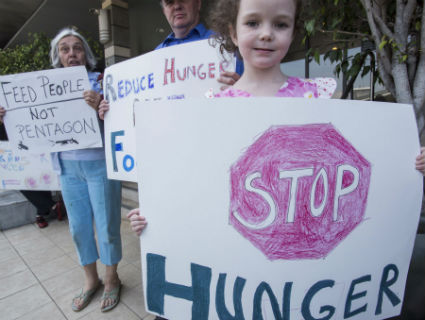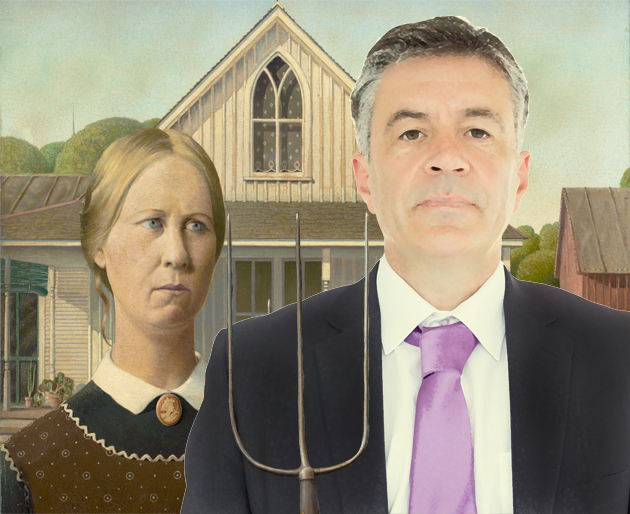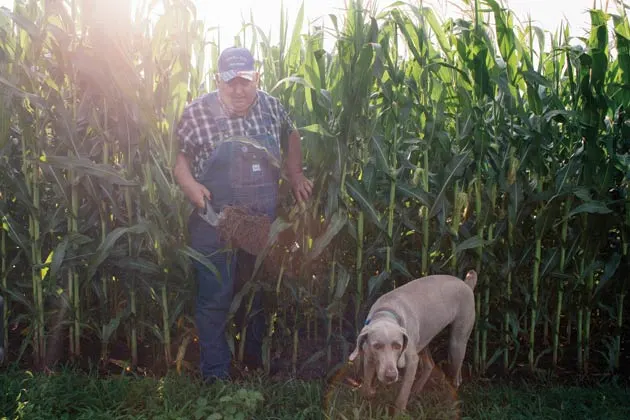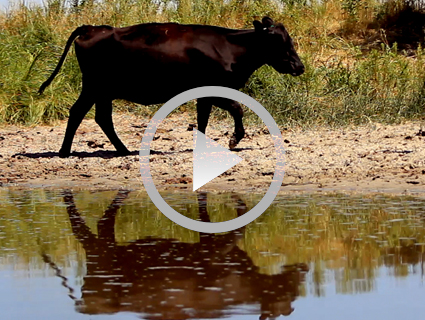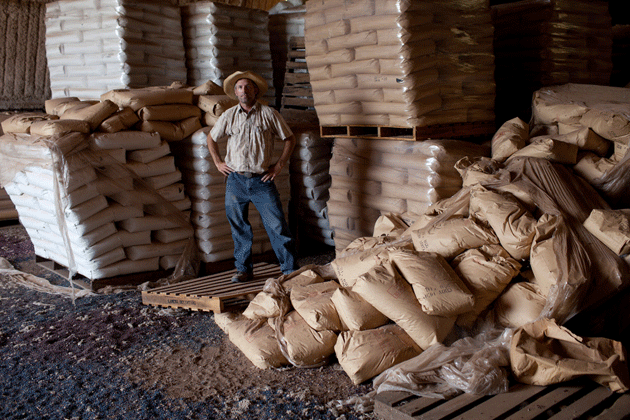
Eric Herm, 40, unloads non-genetically-modified cotton seed into a storage barn on his 6,700 acre farm in West Texas. Photograph: <a href="http://bendepp.photoshelter.com/#!/index" target="_blank">Ben Depp</a>
In 2011, Eric Herm’s cantaloupes exploded.
A fourth-generation cotton farmer in West Texas, Herm was experimenting with a home garden to help feed his family during the onset of a drought in the area. Blistering heat, including 100-degree days as early as May, was wilting Herm’s cotton—and in the end, it turned his melons into pressure cookers.
Most of Herm’s neighbors have lost their cotton crop the last three of four growing seasons—part of the most severe regional drought in more than 50 years. According to the National Oceanic and Atmospheric Administration, 2012 temperatures in the United States were the hottest in recorded history. And a May 2013 report by the American Meteorological Society’s Journal of Climate concluded that “human-induced climate change” played a statistically significant role in the record-breaking temperatures of 2011, adding that the period from October 2010 to September 2011 “was Texas’s driest 12-month period on record.”
With the exception of scattered irrigation, most farmers in West Texas practice “dryland” farming, meaning they’re entirely dependent on rain. Rainfall on Herm’s acreage had previously averaged 17 inches a year, but in 2011 and 2012 the annual averages were 3 and 8 inches, he said. Even the driest years of the Dust Bowl, which lasted off and on from 1930 to 1940, brought about 9 to 14 inches of rain to Herm’s region, according to Natalie Umphlett of the Nebraska-based High Plains Regional Climate Center.
“In the back of my mind I’m wondering, ‘Where do I go if things get that bad?'” Herm said back in May, while planting for the 2013 growing season. “If we do not make a crop this year, I’m going to have to a real serious look at [the] future.”
The latest news is not reassuring. As of October 2013, more than 80 percent of Herm’s neighbors declared their cotton a failure and collected crop insurance claims, subsidized by US taxpayers.
If recent research by the US Department of Agriculture is any indication, the crop failures will be a sign of the future. In a February 2013 report, the agency rounded up relevant scientific findings from 56 experts from federal service, universities, and nongovernmental organizations. The results cast doubt on the viability of the US heartland in the age of warming—and not just for dryland cotton. “Continued changes by mid-century and beyond,” the report said, “are expected to have generally detrimental effects on most crops and livestock.” Among other problems, “weed control costs total more than $11 billion a year in the US. Those costs are expected to rise with increasing temperatures and carbon dioxide concentrations.”
Interviews with more than a dozen climatologists, agronomists, agro-economists, and agricultural statisticians have generally echoed the USDA’s prognosis: After about 30 years, greenhouse gas concentrations will reach critical enough levels to significantly disrupt agriculture. But even the next 10 years will probably prove challenging for American farmers, because the weather will be more variable. As Columbia University associate professor of international and public affairs Wolfram Schlenker put it, “There’s more certainty that there will be less certainty.”
In any case, taxpayers are on the hook for climate-related disruption of US food production—mainly in annual outlays for crop insurance. In February 2013, the same month that the USDA released its bleak assessment on global warming, the Government Accountability Office released a statement warning about the federal government’s “fiscal exposure to climate change,” including the crop insurance program.
Based on USDA data, if the current version of the farm bill were extended 10 years into the future, even without expansions under debate, crop insurance would cost $8.41 billion per year, or $84.1 billion total, according to Jim Langley of the Congressional Budget Office. With the expansions the projected costs rise to about $99 billion. And that figure does not account for recent climate-related impacts on crop yields, including the drought of 2011 and 2012 in Texas and the Midwest.
“We treated those two years as outliers,” said Langley. “We don’t explicitly take into account climate change. It’s not like something dramatic is going to happen in next ten years. We assume weather going to be normal.”
To be sure, it’s hard to turn estimates about climate impacts on agriculture, and by extension crop insurance outlays into hard numbers. And there’s no consensus that taxpayers will pay more than projected. Advocates of crop insurance claim that the program works better than disaster relief. “It forces farmers to manage risk before, not after it happens, which saves taxpayers money,” Tom Zacharias, president of National Crop Insurance Services, an industry group, has written.
Still, the tab has been steadily rising. According to the Midwest Center for Investigative Reporting, taxpayer subsidies for crop insurance averaged $3.1 billion annually between 2000-06, but have more than doubled to an average of $7.6 billion for 2007-12. Much of the fiscal bleeding has resulted from what’s called a “harvest price option,” an insurance option that compensates farmers for the revenue they missed when prices skyrocket amid climate-related scarcity. In the extreme weather since 2009, costs have tripled overall, rising every year from about $4.8 billion to the record high of more than $13 billion in 2012, according to Patrick Westhoff of the University of Missouri’s Food and Agricultural Policy Research Institute.
These increasing costs, at least partially related to climate variability, have called attention to the role of crop insurance in the farm bill. Under the new bill, the crop insurance program would largely replace traditional crop subsidies, becoming the main way taxpayers are asked to support farmers. On Wednesday, a House-Senate conference will begin to reconcile two versions of the bill, both of which are strongly favored by agribusiness and insurance interests. Most of the politicking has long since been choreographed, as a range of lobbying reports and campaign contributions could attest. But the stakes in the debate are profound and long lasting, and they can be seen clearly in the desiccated row crops of West Texas.
Quinton Kearney, 38, who farms with his wife and five employees near Lamesa, Texas, about 60 miles south of Lubbock, started out in 1996 with 700 acres and steadily expanded to 9,700 acres. Like other farmers in the area, Kearney lives in a comfortable middle-class home.
But after three years of drought and two failed crops, Kearney’s margins have become razor thin. Since insurance payouts are based on past yields, every year a farmer loses his crop means he can claim less the following year—even as his premiums go up. “It’s rough,” Kearney says. “There’s only so much salary you can pay after three years of drought and still have cushion if the banker calls in the chips.”
Another farmer, Steve Bodine, who farms 2,000 acres about 40 miles south of Kearney, barely broke even the previous two years, even after collecting on claims. He had similar luck in 2013. “Three in a row, it’s getting really hard to stomach,” Bodine said.
Given an average crop price, insurance claims might provide margins of 1 or 2 percent, according to farmers in the area. By guaranteeing at least this minimum margin, taxpayers are keeping conventional large-scale farmers on the land. But perhaps just as importantly, they are subsidizing the producers of expensive things that farmers buy each year—starting with seed.
In a normal year, virtually all of the cotton farmers around here plant Monsanto’s Roundup Ready “technology,” as they call it. The advantages are obvious: It saves tremendous time, doing away with hoeing crews for weeding and related personnel management. The labor is essentially replaced by a large spray rig, a 400-gallon tank filled with Roundup, and fuel to drive it through the fields maybe twice a season. The spray kills everything except the cotton, which is genetically engineered to resist it.
But the drought has temporarily called into question the use of GMO seeds. At planting time this May, the ground was essentially dust, with almost no chance for seeds to grow. In such unfavorable conditions on the heels of two straight crop losses, no smart farm manager on the southern plains would feel comfortable investing in expensive technology.
In a previous era, after a dry winter on the heels of three drought years, the grandparents of today’s farmers would not have spent the money even to plow the land for planting. They would have let the ground fallow and tried to find a job, perhaps in the oil fields, hoping to return with the rains. But today’s generation can collect on crop insurance, which means they do things differently.
To be eligible to file a crop insurance claim, a farmer is required to plant the seed. That provision provides a built-in advantage to the seed companies, because farmers must plant by government-mandated deadline, no matter how futile the act of doing so. But Roundup Ready cotton seed is expensive—as much as $350 to $400 a bag, farmers said, which can amount to more than $100,000 in annual seed costs. In interviews, every one of a half-dozen local farmers who normally purchased Monsanto technology said they simply abandoned the practice this year. Instead, they purchased conventional seed at one-fifth the cost. Then they planted it, knowing that it would be very hard to turn it into a successful crop—but that if the crop failed, insurance might keep them afloat until the rains returned. That would give them a chance to resume normal practices.
“It’s a no-brainer,” said Louis Addison, an agent with Adams Crop Insurance in Lamesa. “It doesn’t make much sense to put a $350-to-$400 bag in a dry seed bed when you own or are storing good viable seed in your barn. They were just seeding to satisfy their insurance requirements.”
The crop insurance program works in favor of the companies that produce the GM seeds—and a range of other related agricultural inputs—that farmers in the area typically buy in non-drought years. No wonder, then, that more than 120 insurance and farm interests, from John Deere and Monsanto to the insurance companies Ace and Wells Fargo, lobbied for crop insurance in 2012. (In an email, Monsanto spokeswoman Christy Toedebusch declined to comment on the role of federally subsidized crop insurance, noting that the company is in the process of purchasing the Climate Corporation, which will allow it to sell supplemental crop insurance. She added that the company’s seed pricing “is in line with the marketplace.”)
Even if the rain came, it would have been extremely difficult to produce a crop with the conventional seed the farmers planted. That’s because it would have required old-fashioned weeding—spraying Roundup would have taken out the plants along with the weeds—and these farms were mostly too big for that. They would have had a hard time summoning up the old hoeing crews from the pre-biotech days.
“We used to have migrant crews that would come in and take care of the weed problem,” says Addison, “but the GM seeds have basically done away with that. It makes it very difficult on the farmer, you’re almost pushed into this GM seed deal because it’s about the only way to farm anymore.”
Of the farmers I interviewed who abandoned Monsanto seeds this year, every one ended up filing for an early crop failure, adding to taxpayer subsidies. Addison did not know any such farmer who made a crop.
Even if the rains return, the farmers of West Texas face a string of economic and ecological dilemmas that could affect their bottom line. In place of labor, farmers now pay for GMO seeds, diesel, fertilizer, $200,000 spray rigs, and other sophisticated equipment. The smart farmers see only one way out: “We have to do it on a lot of acres,” Kearney said. “It’s the only way we can make it work.”
Following a nationwide trend, the farms in West Texas grew significantly larger as biotech seeds spread in the 1990s and have not shrunk since then. Crop insurance has facilitated the trend. Federal subsidies cover about 60 percent of farmer’s crop insurance costs on both ends—premiums and payouts. Banks treat the subsidized insurance as collateral to finance expenses during the growing year. Farmers can also pay higher premiums to guarantee a high portion of revenue—as much as 75 percent. The result is that the subsidies drastically reduce the risk of annual operations—and of expansion.
But this risk reduction brings risks of its own. The Environmental Working Group found that crop insurance has played a role in encouraging farmers to expand row crops onto marginal land like wetlands or prairie, which exacerbates vulnerability to erosion, floods, and drought.
And yet the crop insurance program provides no formal incentive for water conservation or soil preservation, key elements in climate adaptation. On their own a few farmers around here experiment with traditional conservation practices, including cover crops. Some farmers have recently planted black-eyed peas and other secondary crops in the wake of cotton failures, bringing new nutrients to the soil. Others participate in voluntary paid conservation set-aside programs, which increases acreage for wildlife.
But they don’t talk about global warming. They talk about drought, which is something their elders survived in the ’30s and ’50s by dint of off-farm work, gardens, and butchered hogs. Even those who monitor climate science and allow themselves an occasional “sinking feeling,” as one farmer put it, are constrained by the stubborn optimism that is necessary for farming. If you thought more than one year out, one told me, “you couldn’t get out of bed in the morning.”
So what if the government were to pull the plug on crop insurance? It would mark the end of independent farming on the southern plains, says Bodine, where his family’s been farming almost 100 years. “There is a legacy here,” he told me. “You do away with crop insurance, there’s no way people can get financed.”
But Bruce Babcock, an Iowa State University agricultural economist and critic of the subsidies of crop insurance, has another idea: If the US scaled down subsidies, he says, it could scale up research in adaptation—identifying what varieties best adapt to drought, researching cover crops and soil moisture, studying where crops should be grown. “That’s going to have to take place in the next 10 to 30 years,” he says. “Farming is like any business—areas that can adapt best to climate change will make more money over time. This kind of [adaptation] support will help farmers more than handouts and crop insurance will.”
If Babcock got his way and funding changed from insurance subsidies to adaptation funding, the farmer who might stand the best chance of surviving are the ones who resisted the trend. Eric Herm, 40, grew up on his father’s farm in Ackerly near Big Springs, left at age 23, and returned in 2005, full of ideas about environmental stewardship, including the home garden full of cantaloupes. He has ensured that the 6,700-acre farm remained free of Roundup Ready cotton: At most, the acreage receives an older-generation herbicide treatment before planting.
In order to practice these non-GMO methods, Herm and his father have retained long-standing relationships with migrant labor from the Rio Grande Valley—about the only farmers around that do so for weeding (some crews have returned this season for secondary crops like sorghum and black-eyed peas).
As it turned out, this workforce saved the Herms during the 2013 planting season. With three weeding crews of 20 to 25 workers each, the Herms’ team was able to go over the crop rows with the routine two passes with a weeding tractor and two passes with hoes. The exception was four passes each on 250 special acres—Herm’s first certified organic cotton crop.
“I can’t tell you how many people told me I couldn’t do this,” says Herm, about the cotton that he says is the only organic variety for 20 miles. “Without herbicides they said you’ll never able to make it work. I worked harder on it, but it’s going to be worth it.” Most habitual Roundup Ready farmers around Herm, even those that received roughly the same rain Herm did, had planted conventional seeds—and failed out their crops in July.
As of early October, Herm was tending to a full crop on most his fields, still hoping for rain before the harvest.
Reporting for this story was supported by the Fund for Investigative Journalism. Additional reporting support was provided by the Midwest Center for Investigative Reporting.
